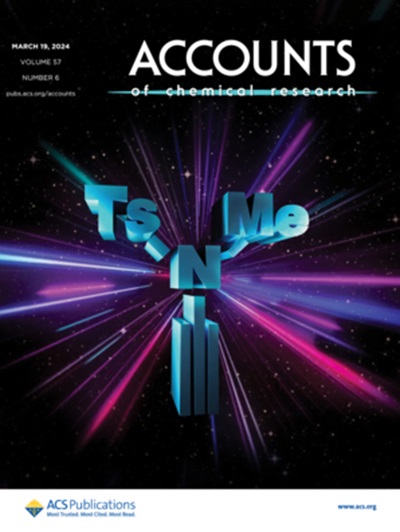核酸与蛋白质内在无序区之间的竞争。
IF 17.7
1区 化学
Q1 CHEMISTRY, MULTIDISCIPLINARY
引用次数: 0
摘要
内在无序区(IDRs)是蛋白质功能的重要组成部分,其电荷分布是决定其作用的关键因素。值得注意的是,许多蛋白质具有高度负电荷的idr,其特征是序列富含天冬氨酸(D)或谷氨酸(E)残基。生物信息学分析表明,带负电、低复杂度的idr比带正电、富含精氨酸(R)或赖氨酸(K)的idr更为常见。例如,268种人类蛋白质中存在10个或更多连续带负电残基(D或E)的序列。相比之下,只有12种人类蛋白质中存在10个或更多连续带正电残基(K或R)的相应序列。有趣的是,大约50%含有D/E束的蛋白质具有dna结合蛋白或rna结合蛋白的功能。带负电荷的idr可以静电模拟核酸,并动态地与它们竞争带正电荷的dna结合域(DBDs)或rna结合域(rbd)。这导致了一种被称为自抑制的现象,其中带负电荷的idr通过分子内相互作用占据蛋白质内的结合界面,从而抑制与核酸的结合。带负电荷的idr不仅降低了结合活性,而且为DNA/ rna结合蛋白的功能提供了显著的优势。带负电荷的idr与核酸之间的动态竞争可以加速这些蛋白质的靶标搜索过程。当蛋白质遇到DNA或RNA时,核酸与带负电荷的idr之间的静电斥力可以触发构象变化,使核酸能够进入dbd或rbd。此外,当蛋白质被困在DNA或RNA上的高亲和力非靶标位点(“诱饵”)时,带负电荷的idr的静电斥力可以将蛋白质从这些陷阱中解救出来。带负电荷的idr作为看门人,拒绝非特异性配体,同时允许靶标进入dbd或rbd的分子界面,从而增加结合特异性。这些idr还可以促进适当的蛋白质折叠,通过取代与DNA结合的其他蛋白质促进染色质重塑,并影响相分离,影响局部ph。带负电荷的idr的功能可以通过蛋白质-蛋白质相互作用、翻译后修饰和蛋白质水解加工来调节。这些特性可以作为蛋白质工程的工具加以利用。一些将带负电荷的idr转化为带正电荷的帧移突变与人类疾病有关。因此,了解与核酸竞争的带负电荷的idr的物理化学性质和功能作用至关重要。本文章由计算机程序翻译,如有差异,请以英文原文为准。
Competition between Nucleic Acids and Intrinsically Disordered Regions within Proteins.
ConspectusIntrinsically disordered regions (IDRs) are important components of protein functionality, with their charge distribution serving as a key factor in determining their roles. Notably, many proteins possess IDRs that are highly negatively charged, characterized by sequences that are rich in aspartate (D) or glutamate (E) residues. Bioinformatic analyses indicate that negatively charged, low-complexity IDRs are significantly more common than their positively charged counterparts rich in arginine (R) or lysine (K). For instance, sequences of 10 or more consecutive negatively charged residues (D or E) are present in 268 human proteins. In contrast, the corresponding sequences of 10 or more consecutive positively charged residues (K or R) are present in only 12 human proteins. Interestingly, about 50% of proteins containing D/E tracts function as DNA-binding or RNA-binding proteins. Negatively charged IDRs can electrostatically mimic nucleic acids and dynamically compete with them for DNA-binding domains (DBDs) or RNA-binding domains (RBDs) that are positively charged. This leads to a phenomenon known as autoinhibition, in which the negatively charged IDRs inhibit binding to nucleic acids by occupying the binding interfaces within the proteins through intramolecular interactions.Rather than merely reducing binding activity, negatively charged IDRs offer significant advantages for the function of DNA/RNA-binding proteins. The dynamic competition between negatively charged IDRs and nucleic acids can accelerate the target search processes for these proteins. When a protein encounters DNA or RNA, the electrostatic repulsion force between the nucleic acids and the negatively charged IDRs can trigger conformational changes that allow the nucleic acids to access DBDs or RBDs. Additionally, when proteins are trapped at high-affinity nontarget sites on DNA or RNA ("decoys"), the electrostatic repulsion from the negatively charged IDRs can rescue the proteins from these traps. Negatively charged IDRs act as gatekeepers, rejecting nonspecific ligands while allowing the target to access the molecular interfaces of DBDs or RBDs, which increases binding specificity. These IDRs can also promote proper protein folding, facilitate chromatin remodeling by displacing other proteins bound to DNA, and influence phase separation, affecting local pH. The functions of negatively charged IDRs can be regulated through protein-protein interactions, post-translational modifications, and proteolytic processing. These characteristics can be harnessed as tools for protein engineering. Some frame-shift mutations that convert negatively charged IDRs into positively charged ones are linked to human diseases. Therefore, it is crucial to understand the physicochemical properties and functional roles of negatively charged IDRs that compete with nucleic acids.
求助全文
通过发布文献求助,成功后即可免费获取论文全文。
去求助
来源期刊

Accounts of Chemical Research
化学-化学综合
CiteScore
31.40
自引率
1.10%
发文量
312
审稿时长
2 months
期刊介绍:
Accounts of Chemical Research presents short, concise and critical articles offering easy-to-read overviews of basic research and applications in all areas of chemistry and biochemistry. These short reviews focus on research from the author’s own laboratory and are designed to teach the reader about a research project. In addition, Accounts of Chemical Research publishes commentaries that give an informed opinion on a current research problem. Special Issues online are devoted to a single topic of unusual activity and significance.
Accounts of Chemical Research replaces the traditional article abstract with an article "Conspectus." These entries synopsize the research affording the reader a closer look at the content and significance of an article. Through this provision of a more detailed description of the article contents, the Conspectus enhances the article's discoverability by search engines and the exposure for the research.
 求助内容:
求助内容: 应助结果提醒方式:
应助结果提醒方式:


